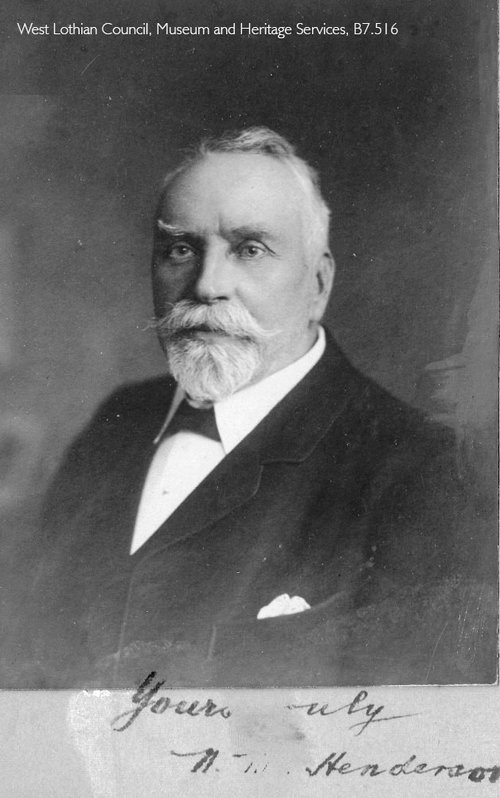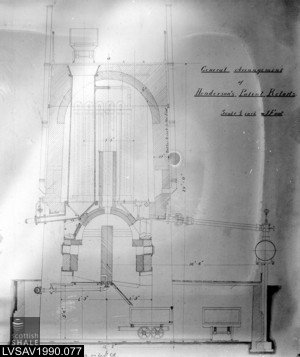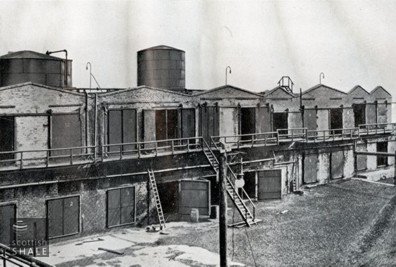Norman M. Henderson (1839-1917)
- Age 32,
- East Cottage, Midcalder
- Manager of Oil Works
- Wife; Helen (25)
- Age 40,
- Broxburn
- Engineer & Manager of Oil Works
- Age 57,
- Broxburn Lodge
- Manager of Oil Works
- Age 61,
- Broxburn Lodge
- General Manager of Broxburn Oil Co.
1871 census
1881 census
1891 census
1901 census
Obituary
The Late Mr Norman M. Henderson

After a long illness borne with marvellous fortitude and patience, the death occurred at his residence, Broxburn Lodge, Broxburn, on Friday 14th inst., of Mr Norman M. Henderson, late manager of the Broxburn Oil Works. By his death there passed away a pioneer of the Scottish Oil Industry, who was closely identified with its struggles and successes for fully half a century, and the community of Broxburn mourns the loss of one who for many years took a deep and active interest in its welfare, and had conferred on it many benefactions.
The deceased gentlemen was born at Bathgate, on the on 3rd December, 1839, and received his education there. He early apprenticed himself as a millwright in his native town, and realising very soon the bent of his mind and his special aptitude for mechanics, he definitely decided to follow engineering as a career. At the end of his apprenticeship as a millwright he entered the employment of the Shotts Iron Co., where he remained for some years, improving himself in engineering and patten-making and taking every opportunity of furthering his general education through private tuition and otherwise. Returning for a short time to Bathgate as patternmaker at Bathgate Foundry, he about 1861 became associated with Dr James Young of Kelly, the pioneer of the Scottish Mineral Oil Industry, and with Mr Edward Meldrum, his partner, who were then carrying on at Bathgate the business of distilling oil from the famous Boghead mineral. Dr Alex. C. Kirk, well known subsequently in shipbuilding circles was at that time their manager, and Mr Henderson became his assistant and draughtsman, in which capacity he acted for several years. Under Dr Kirk's guidance he designed and developed plant well adapted for the distillation of oil, and gained a practical knowledge of the processes which largely moulded and influenced his future career.
In 1869 he entered the service of the Oakbank Oil Company Ltd., which was formed to acquire the works of the old Mid Calder Oil Co. near Mid Calder, in the county of Midlothian. On its formation he was appointed works manager and he not only carried out the reconstruction and rebuilding of the works, but designed much of the plant. He then also, for the first time, became associated with the late Mr William Kennedy, who had been appointed General Manager of the Company, and with whom, until Mr Kennedy's death, about 18 years ago, he was closely indentified in all that they both contributed towards the development of the Scottish Oil Industry. To the very capable business qualities of the one, as well as to the practical and inventive mind of the other, is to be largely attributed the success which enabled the industry to overcome the many difficulties which it had to face in the earlier years of its existence.

While with the Oakbank Oil Company, Mr Henderson invented and patented, in 1873, a retort by which he utilised the spent shale as fuel, and to a great extent revolutionised the process of distillation of shale. Previous to the invention of this retort, shale had been generally distilled in vertical or horizontal iron retorts by coal fires. Great care was required in stoking, otherwise the retorts themselves were burned, and lasted only a short time, while the crude oil was damaged by overheating. In the Henderson retort the spent shale of one charge was dropped into a furnace below and burned there with regulated amount of air. it supplied the heat necessary to distil off the next charge. In this way the temperature was taken out of the stoker's care and overheating rendered impossible. The result was that the retorts lasted very much longer, and the crude oil was improved. There was less loss in refining the crude oil, and a larger proportion of the more valuable products, viz., lubricating oil and solid paraffin was secured. The mechanical arrangements for dropping the spent shale into the furnace were ingenious. This retort was eminently successful, and was ultimately adopted by all the Scottish Oil Companies.
In 1877, when the Broxburn Oil Company Ltd was formed, Mr Henderson became works manager while his friend, Mr Kennedy, was managing director. On Mr Henderson devolved the duty of planning and constructing the new works. He was free to carry out his own ideas. Endowed with great health and strength, he could work night and day continuously, and he was of eager, enthusiastic spirit. He practically designed every detail. He knew what had been done before, and how, but he had to re-design everything. He was original, bold, ingenious, and even old methods took a new form from him.
These outstanding qualities of body and mind stood him good stead throughout the depression which from 1885 to 1895 seriously affected the Scottish Mineral Oil trade. The fall in the prices of all products could only be met by lessening the costs of manufacture, and this necessitated not only the observance of the most rigid economy in every department, but also the introduction of improvements by which savings could be largely effected in labour, chemicals, and maintenance.

He early invented a cooling machine, whereby heavy oil and paraffin was chilled rapidly. But rapid cooling was not suitable for getting good crystals. Mr (now Sir George) Beilby, patented a method for slow crystallation. Mr Henderson had to seize this idea, and make a very perfect working apparatus. The old method of refining paraffin wax by treatment with sulphuric acid and soda was expensive and wasteful. Refining by sweating had been tried by someone, and worked out with little vessels and much labour. Mr Henderson worked out the process on a grand scale, by methods which reduced labour to a minimum and proved most successful, and which were taken up all over the world for shale and petroleum paraffin. His plant was patented in America, and the sole right to use the patent in that country was acquired by the Standard Oil Co.
Another invention that proved of great value was that of the continuous-working connected boiler stills. These stills are worked in a series, night and day, for many months at a time, and at the same temperature, so that they lasted many years. The distillation was more perfect, and the labour and fuel reduced. At the time of the invention of this process an extension of the works was needed, and by connecting the boiler stills in this way the throughput was doubled without any increase of plant.
Improvements in retorts erected at Broxburn gave a great increase in the yield of ammonia. He also invented a very perfect method of saving the valuable permanent gas which had previously been lost in the process of oil distillation and with this gas Broxburn and Uphall villages are now lighted.
In recognition of his merits as a inventor, he was awarded a gold medal at the Industrial Exhibition of Industry, Science and Art, held in Edinburgh, in 1886.
Following on his valuable services, he was, in 1895, elected a director of the Company, and continued in that capacity till 1912.
In 1896, however, his eyesight began to fail, and eventually he became totally blind. Such a calamity would have ended the business career of most men actively engaged in such work as Mr Henderson had been doing, but, with his indomitable will power, he struggled against his affliction, and kept at his post for a good number of years, during which, under his guidance a large portion of the Company's Works was successfully reconstructed.
Notwithstanding the clamant demands of his business life, Mr Henderson found time to devote himself in large measure to public affairs. Since his coming to Broxburn, in 1877, he had always manifested interest in the progress of the town, and in 1890 he was returned to the first County Council of Linlithgow, as representative for the Uphall (North) Division. He rendered valuable services on the Bathgate District Committee, and in county matters generally, continuing to represent the same Ward for twenty years, till the election in November, 1910, when he retired being succeeded by the present representative Mr William Cuthbertson.
He also for a short time was a member of the Uphall Parish Council, and was a Justice of the Peace for the County.
While his interest in educational matters had always been keen, it was not till 1891 that he would allow himself to be nominated for election to Uphall School Board. In that year, however, he sought election, and was returned as a member in April. The School Board at that time comprised seven members, and the gentlemen returned along with Mr Henderson were - Mr John Kennedy, the late Messrs John Bagshaw, John Calderhead, John McKnight, John Wilson and the Rev. Canon O'Neill. His fellow members at once recognised the help likely to be received from him, as they appointed him Chairman at their first meeting. He sat on three successive Boards, retaining his position as Chairman for nine years, retiring in 1900. During these nine years he saw large additions and extensions made to the Public Schools at Broxburn and Uphall, the greatest of which, no doubt, was the building of the handsome two-storeyed addition, facing the public street, at Broxburn School. There were occasions during his tenure of the chairmanship when some of his colleagues did not see eye to eye with him on certain questions, and breezy meetings at times ensued. Even his opponents, however, recognised his singleness of purpose, and agreed to differ. Though he retired from the Board, his interest in the work and development of the school continued, and for a number of years back he had annually provided one of the gold medals awarded to the dux boy and dux girl in the Higher Grade Department.
As has been already indicated, he took a very deep and active interest in the public welfare, in other-directions of Broxburn, and was instrumental in the success of various public institutions. He gave valuable assistance in the formation of the Broxburn Bowling Club, formed in 1893, and to his exertions in large measure was due the successful opening of the green in June 1894. The first President of the Club he, later on, became an Honorary President, continuing as such up to the time of his death. He gave the prize - a silver medal - for the first single-handed championship of the green, and annually, ever since, he held himself responsible for the championship prize. He was also an honorary official of the Broxburn Golf Club, and a steady patron.
The Broxburn Public Brass Band received much encouragement from him. He was a steady friend and well wisher of this body, and had a full share in the movement which led up to the building of the Band Hall some years ago. He designed the building, and gave much financial aid. The fine successes gained later by the Band were a great gratification to him. Believing in the value of the Boy Scout movement, he gave the Broxburn Troop every encouragement and assistance.
His benefactions indeed went far and wide; catholic in scope, generous in measure, they covered all movements which in his view tended to the betterment and well being of the general body of the community, and an appeal to him was seldom, if ever, made inn vain. He was truly, in Scriptural phrase a "cheerful giver".
During the ministry of the Rev. Mr Primrose - now of Cathedral Square Church, Glasgow - he gifted a bell to the U.P. Church - now know as the East U.F. Church - and to the extension made to that church some few years ago he also contributed liberally.
Previous to1886, Mr Henderson was a Liberal in politics, and supported the late Mr McLagan in his candidature, but on the introduction of the Home Rule Bill, in that year, he went over to the Unionist side.
He was a Freemason and Deputy Master of Linlithgowshire Provincial Grand Lodge.
While in full possession of his eyesight he was a familiar figure in the chair at many public gatherings in Broxburn, and even when the darkness of blindness was fully over him, he essayed as long as he was able, such public efforts as seemed to him a duty.
Of rine and manly presence, thought no glib orator, his public utterances on such occasions had a charm of their own, going straight and true to their mark, lit up, as of times they were, with flashes of genuine humour.
In friendly circles his natural wit had full play. He was the soul of a merry party, delighting in a good story, and giving himself up for the time to whatever amusement turned up. To meet him occasionally in this way was a delightful experience.
In regard to duty he was unsparing to himself, and insisted on it from others. Severe at times, to those under him, he kept up no spite, and was invariably kind and generous. In his work for the public good, seeing clearly himself, he carried out with boldness whatever his shrewd commonsense dictated as for the good of the people, brushing aside at times, with scant patience any impediment put in the way of the desired reform by others wishing a restrain or modify his plans. He erred like other human beings sometimes, no doubt, but with all, he was a man of the purest intentions, honesty, and genuine chivalry.
Since 1912, when he retired from the Directorship of The Broxburn Oil Company, he had for the most part been a confirmed invalid, but that exuberance of spirit and ready repartee, which was so much enjoyed by his numerous friends, who were constant in their attention to him, continued almost until the end.
Some eight weeks ago his illness reached a critical stage, and though he rallied frequently for days at a time, it was evident the end was drawing near, so that his death last week was not unexpected.
The funeral, which was of a public character, took place on Wednesday to Bathgate Old Churchyard, and the cortège left Broxburn amid manifestations of deep public interest.
Amongst those following the cortège were, Mr Andrew Henderson, Drybridge; Mr John Henderson, Shotts; (brothers of the deceased); representatives of the Scottish Oil Industry included – Mr Wm. Love, Mr W. Montgomerie, Mr A Buchanan, Mr Kerr, Mr Cowan, Mr Jas. Bryson, Pumpherston; Mr A.C. Thomson, Oakbank; Mr Wm. Caldwell, Pumpherston; Mr J.B. Sneddon, Oakbank; Mr A.H. Crichton, Philpstoun; Mr W.W.M. Wilson, Uphall; Mr J.W. Anderson, Addiewell. Other friends - Mr R. Rough, Mr Wm. Brand; Dr Scott, Mr R. Hastie, Dr Kelso, Mr John Kennedy, Mr F. Stuart, Mr G. S. Morrison, Rev. J. A. Orr, Rev. A. Bain, Rev. R. Erskine, and others, Broxburn; Rev. Jas. Primrose, Glasgow, Rev Mr Dunn, Uphall; Rev. Mr Lindsay, Bathgate; Mr D.R. Gordon, Mr John Frew, Mr Andrew Simpson, Bathgate; Mr R. McLaren, Mr G.D. Wilson, Edinburgh; Mr J Morris, Corstorphine. Representatives of the Broxburn Oil Works included - Mr Wm. Cuthbertson, Mr Wm. Clark, Mr D. R. Stewart [sic], Mr R.L. Chambers, Mr Jas. Constable, Mr T. Nicol, Mr A. Hamilton, Mr Wm. Ritchie, Mr Jas. Mitchell, Mr G.T. McKillop, Mr A. Fleming, Mr M. Cowan, Mr John Roller, Wm. Calderhead, Jas. Laurie, Wm. Pagan, etc.
In recognition of the deep interest the deceased gentleman had always taken in matters pertaining to education, the head master of Broxburn Public School, Mr Brown, and his assistant, Mr Tennant, had all the boy pupils assembled in double lines in front of the school, and as the cortège passed the boys gave the "salute", their last sign of respect to the man whom their fathers knew, and whose name will be heard in Broxburn for many years as a "household word".
West Lothian Courier 21st December 1917
Above left: Drawing of Henderson's Patent Retort, 1889.
Above right: R11-00022 Henderson Wax Sweating Sheds, Source: The Oil-Shales of the Lothians, 1927.